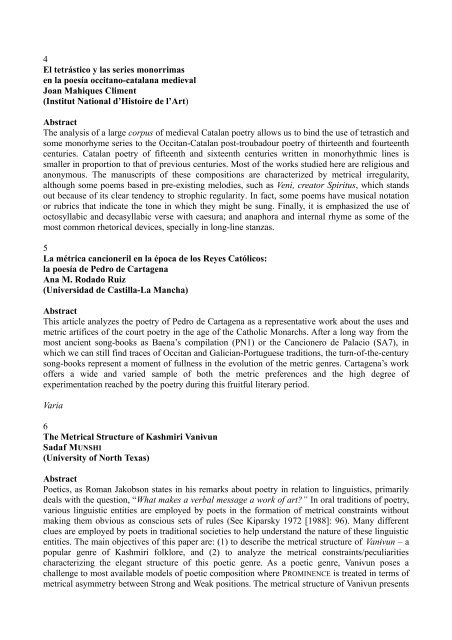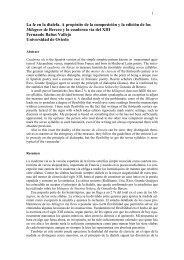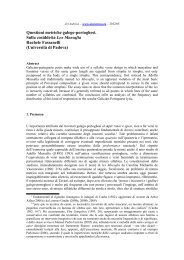Ars Metrica 2012/05 The Galician-Portuguese Lyrical Poetry in its ...
Ars Metrica 2012/05 The Galician-Portuguese Lyrical Poetry in its ...
Ars Metrica 2012/05 The Galician-Portuguese Lyrical Poetry in its ...
Create successful ePaper yourself
Turn your PDF publications into a flip-book with our unique Google optimized e-Paper software.
4<br />
El tetrástico y las series monorrimas<br />
en la poesía occitano-catalana medieval<br />
Joan Mahiques Climent<br />
(Institut National d’Histoire de l’Art)<br />
Abstract<br />
<strong>The</strong> analysis of a large corpus of medieval Catalan poetry allows us to b<strong>in</strong>d the use of tetrastich and<br />
some monorhyme series to the Occitan-Catalan post-troubadour poetry of thirteenth and fourteenth<br />
centuries. Catalan poetry of fifteenth and sixteenth centuries written <strong>in</strong> monorhythmic l<strong>in</strong>es is<br />
smaller <strong>in</strong> proportion to that of previous centuries. Most of the works studied here are religious and<br />
anonymous. <strong>The</strong> manuscripts of these compositions are characterized by metrical irregularity,<br />
although some poems based <strong>in</strong> pre-exist<strong>in</strong>g melodies, such as Veni, creator Spiritus, which stands<br />
out because of <strong>its</strong> clear tendency to strophic regularity. In fact, some poems have musical notation<br />
or rubrics that <strong>in</strong>dicate the tone <strong>in</strong> which they might be sung. F<strong>in</strong>ally, it is emphasized the use of<br />
octosyllabic and decasyllabic verse with caesura; and anaphora and <strong>in</strong>ternal rhyme as some of the<br />
most common rhetorical devices, specially <strong>in</strong> long-l<strong>in</strong>e stanzas.<br />
5<br />
La métrica cancioneril en la época de los Reyes Católicos:<br />
la poesía de Pedro de Cartagena<br />
Ana M. Rodado Ruiz<br />
(Universidad de Castilla-La Mancha)<br />
Abstract<br />
This article analyzes the poetry of Pedro de Cartagena as a representative work about the uses and<br />
metric artifices of the court poetry <strong>in</strong> the age of the Catholic Monarchs. After a long way from the<br />
most ancient song-books as Baena’s compilation (PN1) or the Cancionero de Palacio (SA7), <strong>in</strong><br />
which we can still f<strong>in</strong>d traces of Occitan and <strong>Galician</strong>-<strong>Portuguese</strong> traditions, the turn-of-the-century<br />
song-books represent a moment of fullness <strong>in</strong> the evolution of the metric genres. Cartagena’s work<br />
offers a wide and varied sample of both the metric preferences and the high degree of<br />
experimentation reached by the poetry dur<strong>in</strong>g this fruitful literary period.<br />
Varia<br />
6<br />
<strong>The</strong> <strong>Metrica</strong>l Structure of Kashmiri Vanɨvun<br />
Sadaf MUNSHI<br />
(University of North Texas)<br />
Abstract<br />
Poetics, as Roman Jakobson states <strong>in</strong> his remarks about poetry <strong>in</strong> relation to l<strong>in</strong>guistics, primarily<br />
deals with the question, “What makes a verbal message a work of art?” In oral traditions of poetry,<br />
various l<strong>in</strong>guistic entities are employed by poets <strong>in</strong> the formation of metrical constra<strong>in</strong>ts without<br />
mak<strong>in</strong>g them obvious as conscious sets of rules (See Kiparsky 1972 [1988]: 96). Many different<br />
clues are employed by poets <strong>in</strong> traditional societies to help understand the nature of these l<strong>in</strong>guistic<br />
entities. <strong>The</strong> ma<strong>in</strong> objectives of this paper are: (1) to describe the metrical structure of Vanɨvun – a<br />
popular genre of Kashmiri folklore, and (2) to analyze the metrical constra<strong>in</strong>ts/peculiarities<br />
characteriz<strong>in</strong>g the elegant structure of this poetic genre. As a poetic genre, Vanɨvun poses a<br />
challenge to most available models of poetic composition where PROMINENCE is treated <strong>in</strong> terms of<br />
metrical asymmetry between Strong and Weak positions. <strong>The</strong> metrical structure of Vanɨvun presents






